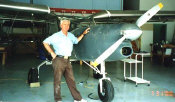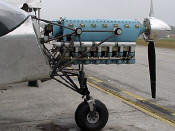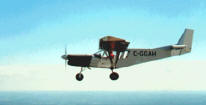 Aircraft Flown: Aircraft Flown:
STOL CH 801, serial no. 8-4114, registration C-GGAH (Canada), built by Art Mitchell.
Engine: LOM M337B (supercharged), rated at max. 235
HP @ 3000 rpm (5 minutes) and 210 HP @ 2700 rpm (max. continuous).
Propeller: 75" two-blade metal ground-adjustable prop (to take full advantage of the
power supplied by the LOM 337B engine, a constant speed or inflight-adjustable prop would
be required).The STOL CH 801 just came out
from the paint shop and it looks both great and impressive: It's a big aircraft and the
nice streamlined cowl (developed by Airlink
Technologies) enclosing the inline six cylinder engine makes the aircraft look large
and "aggressive" up front. (One could paint a shark's head with bared teeth to emphasize the "bite"!) The nosegear was moved forward (due to the length
of the engine) with a custom engine mount / nosegear assembly. With (heavy) battery
placement in the aft fuselage the center of gravity was right on upon weighing the
aircraft (after painting). The CH 801 weighed in at 1,330 lbs., as equipped and
built. Neither the most forward or rearward position of the C.G. is exceeded with normal
loading of the airplane.
emphasize the "bite"!) The nosegear was moved forward (due to the length
of the engine) with a custom engine mount / nosegear assembly. With (heavy) battery
placement in the aft fuselage the center of gravity was right on upon weighing the
aircraft (after painting). The CH 801 weighed in at 1,330 lbs., as equipped and
built. Neither the most forward or rearward position of the C.G. is exceeded with normal
loading of the airplane.
The engine started easily by following the engine manual's
procedures. The sound was surprising at low RPMs (reminding me of my big snow-blower
tractor!) but became "normal" with some increased RPM. The re-placed nosegear
provided responsive and precise steering and shock absorbency during the ground roll was
excellent. The brakes were adequate, holding the aircraft to a static RPM up to 2,300. Mag
checks give RPM drops of 30 - 40 rpm.
Pushing in the throttle to full with the supercharger on
gives more than enough power for excellent short take-off performance - easily within 150
feet with pilot and 20 gallons on board. Subsequent flights at full gross weight yielded
take-off rolls of 280 feet. The rate of climb is quite good: about 1,600 fpm solo,
and about 1,200 fpm at gross. (With the installed fixed-pitch prop, as pitched, the engine
performance was limited to 180-hp max. To take full advantage of the power from this
engine requires an inflight adjustable prop (to run the engine at full RPM). LOM supplies
such a prop for the engine (though it adds additional weight and cost).
As configured, cruise was 98 mph at 2,300 rpm and 105 mph at
2,500 rpm. I verified this with a GPS. Inside the aircraft, the noise level and
"sound" is quite similar to other conventional engines. Engine vibrations: there
are none! This was the biggest surprise of my flights in this aircraft. The engine
runs extremely smoothly at all RPM settings (at least up to the tested 2700 rpm), with or
without the supercharger engaged.
 The
controls and handling of the aircraft were very similar to the standard Lycoming O-360
equipped STOL CH 801... maybe a little heavier due to the larger inertia of the LOM
engine. The aircraft handled well and predictably in all configurations and was
comfortably responsive right down to the "stall" - the usual "mushing
down" of my STOL designs (just over 40 mph at gross weight). The
controls and handling of the aircraft were very similar to the standard Lycoming O-360
equipped STOL CH 801... maybe a little heavier due to the larger inertia of the LOM
engine. The aircraft handled well and predictably in all configurations and was
comfortably responsive right down to the "stall" - the usual "mushing
down" of my STOL designs (just over 40 mph at gross weight).
Approaching the runway with reduced power yields a high
sink-rate. By adding a little power the approach is not "too steep."
Unless one needs to land the plane in a very tight spot the flaps are really not
required for approaches and landings. At full forward C.G., the nose will drop when
touching down on the main gear unless the pitch control (elevator) is held fully back (the
nosegear shock works just fine!).
The aircraft needs almost no trim adjustment: Once the trim
setting for climb has been determined and set (it's not quite the same at forward or rear
C.G.) you need little back-pressure to rotate the aircraft off the ground and it
subsequently climbs hands-off. A little nose-down trim levels the aircraft for cruise, and
again, just a bit more nose-up trim to approach and land (without or with 1/2 flaps).
Steep full-flap approaches require more trim.
The airplane is stable in all configurations and
controllability is very good. (If one is not used to the all flying rudder, a little
practice is recommended, as the rudder is quite effective and needs just light foot
pressure and not any rudder "kicking").
I really liked this airplane. Considering the above
test results, the LOM engine is a good alternative engine for the STOL CH 801 design.
With a good inflight adjustable propeller the engine's power can be fully utilized
and the performance (both take-off and cruise) will improve noticeably.
- Chris Heintz
Midland, Ontario
August 31, 2000.
|

